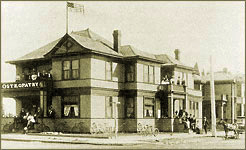Pioneering Osteopathy

 Pioneering Osteopathy in CaliforniaFor over a century now, organized medicine in America has had two separate and distinct divisions: regular medicine and osteopathic medicine. Regular medicine is characterized by medical doctors who have an M.D. degree and is often referred to as “allopathy”. Osteopathic medicine is characterized by osteopathic doctors who have a D.O. degree and is often referred to as “osteopathy”. Members of both professions are legally recognized by federal and state governments and by the military as physicians and surgeons with full practice privileges. There are over 650,000 M.D. and 55,000 D.O. physicians in America. In many communities in America patients have the option of being treated by a D.O. or an M.D.. Yet many Americans do not know about this enriched spectrum of care. The objective of this section is to provide a brief introduction to the historic roots of osteopathy in California. Osteopathy is a healing profession that is unique to America. Osteopathy aimed to improve upon medicine, as practiced in the latter part of the 19th century. While the founder, Andrew Taylor Still, M.D., did not intend to advocate a separate and alternative science of healing, social and political forces created such separation. Dr. Still was disillusioned with his profession, as he felt helpless in saving the lives of his wife and three small children to an epidemic of meningitis, as well as those of many of his patients. Having studied many healing arts of his time, during the late 1800s, he proposed to improve upon allopathic medicine by taking a different, scientific and anatomically based approach to diagnosis and treatment for the whole body. The alignment of the spine comprised an important aspect in assessing the patient’s health, especially for patients presenting with a mechanical problem. He rejected blood letting and surgery, unless as a last resort, and the use of most of allopathy’s pharmacology, at that time called materia medica. Dr. Still often treated patients who were “cast-off” from M.D.s and mainly suffered from chronic ailments. Skillful, painstaking manipulation frequently helped patients and increased the reputation of osteopathy. By 1892, he had become so popular that he was able to open a school for osteopathy in order to train his family members as well as interested M.D.s and others. He called his school the American School of Osteopathy, still in existence in Kirksville, Missouri, today, though now called the A.T. Still University at Kirksville, College of Osteopathic Medicine. Aubrey C. Moore, D.O., one of Dr. Still’s students, moved to Southern California in 1895 upon the suggestion of a grateful patient who wanted this new medical art to be available also in his home state. B. W. Scheurer, M.D., a German physician with subsequent medical training in America, was practicing allopathic medicine in Los Angeles at that time. He had heard about osteopathy and persuaded Aubrey Moore, D.O. to set up a school, and to teach him and other M.D.s about osteopathic medicine. As they started the first osteopathic college outside of Missouri, the Pacific Sanitarium and School of Osteopathy (PSSO) in Anaheim in 1896, they patterned their two year (10 months per year) curriculum after Jefferson Medical College in Philadelphia, one of the finest medical colleges in the country at that time, and after the American School of Osteopathy in Kirksville. While the American School of Osteopathy in Kirksville led to a Diplomat of Osteopathy (D.O.) degree, the PSSO became the first osteopathic medical school to award the Doctor of Osteopathy degree (1898) and to add to the greatest number of D.O.s in the western states. In 1900, 73 D.O.s practiced in California, Oregon, Washington, Arizona, Nevada and Idaho; 40 of these practiced in California. Their school would 70 years later become the origin of UC Irvine College of Medicine. In the late 1880s, southern California had started to advertise its Mediterranean climate for health promotion and healing. The historian Kevin Starr explains in “California, a History” (Modern Library, 2005) that the opening of the transcontinental railroad route into southern California between 1885 and 1887 made possible a middle- and upper-middle class migration that was prompted significantly by hopes for better health. Even the recovery, or at least attenuation, of tuberculosis was anticipated, as patients were advised to alternate plenty of rest and movement in fresh air and sunshine. Osteopathy with its emphasis on well-balanced musculoskeletal movement and nutrition was in a good position to meet the needs of the new health seekers. Indeed, two decades later, Frank MacCracken, D.O. saved many of his patients from succumbing to the flu epidemic in 1918 by opening all their windows to fresh, albeit cold, winter air. Frank MacCracken D. O. had tuberculosis and moved with his family from Nebraska to southern California which must have kept its promises of healing the afflicted because Dr. MacCracken continued to practice and teach osteopathy for many more years in southern California. His daughter, Betsy MacCracken, D.O. followed his foot steps, practicing and teaching osteopathy in Los Angeles. The early years of medicine in California were characterized by distinct differences in the fundamental practices and underlying philosophies that distinguished D.O.s from M.D.s. The best source of information about these early years is contained in an unpublished manuscript by Dain Tasker, D.O. on the history of osteopathy in California, housed at the Special Collections and Archives at the University of California Irvine (UCI) libraries. Dain Tasker, D.O., valedictorian of the first class of PSO in 1998, became a major advocate for osteopathy in California as well as its invaluable historian. Details about his contributions to pioneering the profession in California can be found in chapter 2 of the book “The Merger: M.D.s and D.O.s in California”, published by Xlibris in 2008. |